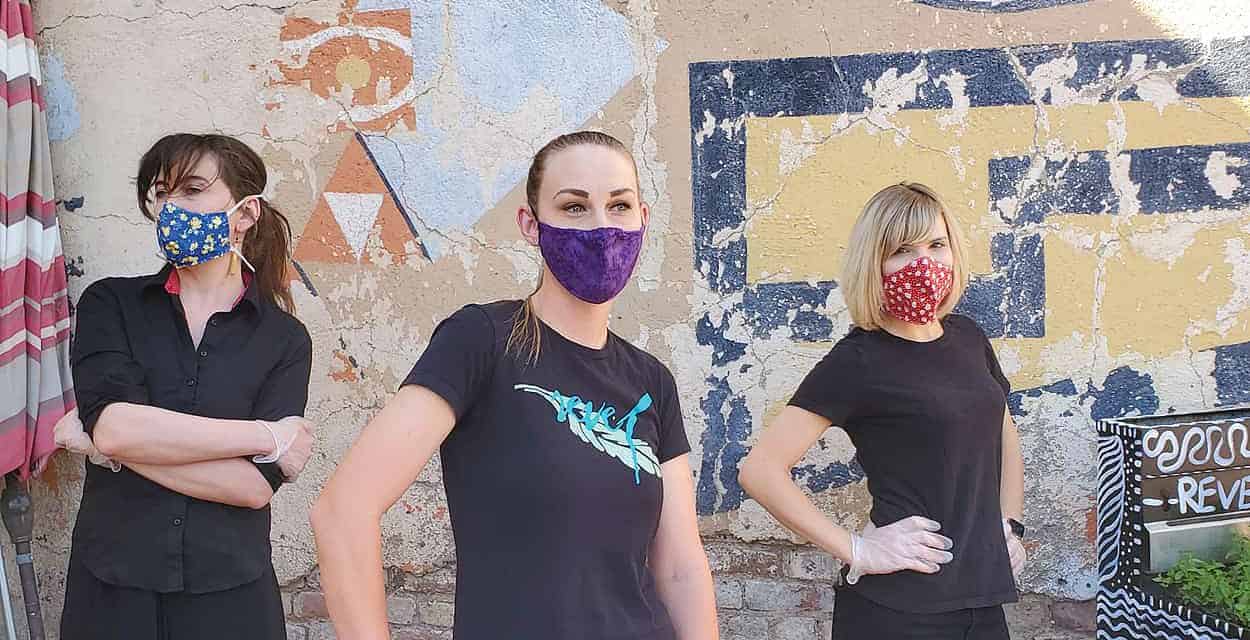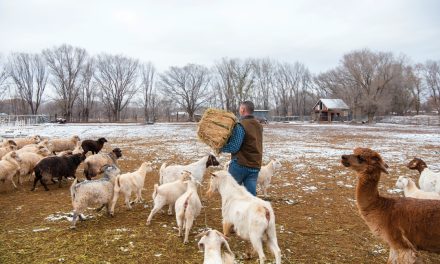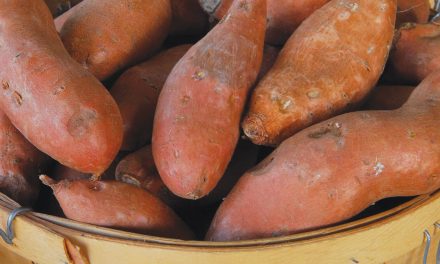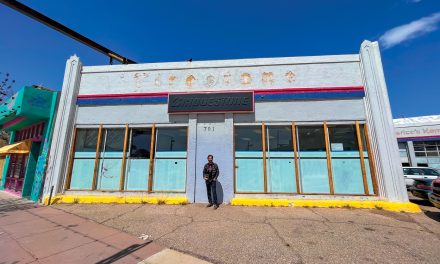A SOCIALLY DISTANT ROUND TABLE
By Briana Olson

Hallie Harris, Jade Johnson, and Codie Bachman at Revel in Silver City. Photo by Kelsey Patterson.
In the last days of May and the first week of June, I talked with local restaurant owners and advocates about their love for what they do, their experience of the coronavirus pandemic, and their hopes and fears for the future of their industry. The following is a compilation of our conversations—something like the discussion we could have had if we’d been able to gather together around a table. Interviews have been edited for length and clarity.
- Carol Wight, CEO of New Mexico Restaurant Corporation, nmrestaurants.org
- Lauren and Jason Greene, owners of The Grove (Albuquerque), thegrovecafemarket.com
- Erin Wade, owner of Vinaigrette and Modern General (Albuquerque/Santa Fe), and The Feel Good (Albuquerque), vinaigretteonline.com
- Jay Guthrie, co-owner of Duran Central Pharmacy (Albuquerque), duransrx.com
- Kelsey Patterson, co-owner of Revel (Silver City), eatdrinkrevel.com
- Camille Bremer, co-owner of Radish & Rye (Santa Fe), radishandrye.com
- Brian Bargsten, co-owner of Arroyo Vino (Santa Fe), arroyovino.com
- Ken Carson, Jr., owner of Nexus Brewery and Nexus Blue Smokehouse (Albuquerque), nexusbrewery.com
Let’s start with the beginning—when did you realize that you would have to close?
Lauren Greene: Mid-March, when the news broke that this was happening, our sales dropped quickly. Day 1 was 50 percent down, day 2 was 70 percent down, day 3, it was like, oh my gosh, no one is coming into the restaurant.
Erin Wade: It was unbelievable how quickly it happened. One day, relatively normal sales with people starting to get a little bit scared, and then there was no one. No one in town, no one out; we couldn’t stay open. It was completely understandable, but also—shocking.
Jay Guthrie: We tried the 50 percent thing for a couple of days and realized, one, that we weren’t prepared to protect our staff with the way it was. And it just—it didn’t work. So we actually closed two or three days before the governor said, Close.
Kelsey Patterson: It seems so long ago, yet so short. I believe it was mid-March, or around St Patrick’s day, where we first reduced to 50 percent dining capacity, and it was just a couple of days later that the governor made the call to close dine-in and shift to carry-out only.
Camille Bremer: It was the Sunday night before the eighteenth, so that would be the sixteenth of March. I’d been hearing about this, the virus. It was starting to get scary. More cases were showing up across the country. I remember that night, I said, I don’t think we should open on Tuesday.
Brian Bargsten: I knew it wasn’t going to be two weeks—I knew it was going to be at least probably close to two months. We had been talking for a couple weeks about having plans to have to-go food and how we would modify that.
Ken Carson: I chose to close one store, Nexus Blue Smokehouse, and keep the other one open. Sitting there and just carrying the expenses, and not having any resources, in addition to laying off all my people, was not acceptable. I was very distraught over the future.
What went into that? Tell me about the process of closing.
Jay Guthrie: Once we stopped crying, we basically emptied our supplies of perishable food and distributed it to our staff, and then we spent the better part of a day deep cleaning. We weren’t sure if we’d be back the next week, or when, but we thought, at least when we stepped back in, it would be clean.
Kelsey Patterson: A lot of really hard calls to team members. Some crying, some hugging. I get emotional just thinking about it. Calling all our farmers, our growers, co-ops, different food purveyors to let them know that we were going to be temporarily shutting down and to put everything on hold.
Erin Wade: What was overwhelmingly on my mind—it’s kind of all a blur now—but when this all happened, was, how am I gonna get my staff paid? We couldn’t pay taxes; we couldn’t pay any of our vendors. I maxed out my credit cards to pay the small vendors I knew were in the same situation as us. I put all the money I had in my own checking account to cover payrolls. So it was like a video game.
Lauren Greene: Our first focus was making sure that all our employees—some have been with us for fourteen years—making sure that we were giving them the tools to get their unemployment going. Then we started the process of messaging to our guests. As much as the Grove could be the Grove during that time, communicating, this is what we’re doing, and why we’re doing it.
Camille Bremer: And then it was dealing with everything fluid—fresh produce, deliveries of things that will expire. We did a lot of canning; we pickled cauliflower and radish and beets and—I swear I had beets for three weeks for dinner. We reduced a bunch of the wines that we have by the glass and made demi glaze and put it in the freezer. Turning off the ice machine and getting the ice out—all these little things that people don’t think about.
Ken Carson: On the BBQ store, I had all this meat and food that I needed to get rid of. So I picked a date, the twenty-eighth of March, and said that would be the last day. We discounted 25 percent on everything and basically emptied the store. Anything left I was able to take to our main restaurant. We had never done takeout at this location. I’d already cut my teeth on it at the BBQ place, and I already had ChowNow and DoorDash, but I was afraid to use them at this location. We get very busy—it would overburden our kitchen if I had a lot of orders.

What role did the state play in preparing restaurants for the stay-at-home orders? What guidance and support has the government offered, at the federal or state level?
Carol Wight: They issued a press release and restaurants had to abide by it. There was no preparation whatsoever.
Lauren Greene: Their direction was very clear in the beginning—to flatten the curve, this is what we had to do. It wasn’t helpful or easy to take. It was understood, and we wanted to be part of the solution.
Brian Bargsten: I don’t think that they needed to prepare us—that’s not their responsibility. With regard to the timeline for reopening, I would call it disrespectful. If you think about what you have to do, to bring staff back, order food—you can’t do that in a day.
Erin Wade: I think our governor has done a good job, in the sense that she’s been more definitive. In Texas, they didn’t declare COVID an economic disaster [which impacted applications for economic injury disaster loans].
Jay Guthrie: There have been some inequities of the way things were locked down, but based on the science of what is still in front of us, I think the state, specifically the governor, who’s taken the brunt of it, has done a pretty good job. I think the large corporations should have endured more of the difficulties that the small, non-corporate businesses had to endure, and that’s what I mean by inequities.
Ken Carson: The majority of the help has been paying attention to various restaurant periodicals that I get online . . . I focused on [the NMRA] because they deal with everything New Mexico. The other has been the brewers’ association, the New Mexico Brewers Guild.
Carol Wight: The federal government was doing what we were doing, which was reacting to things too late. That’s what the payroll protection program (PPP) was as well. They wanted people to be able to keep employees on their payroll, so that employees wouldn’t get on the state unemployment plan. But it was already too late for our industry because people had already been laid off, so to get the PPP we had to rehire employees and have them do nothing because there was nothing to do because we were still shut down.
Camille Bremer: Once we got that money, the PPP money, we looked at the guidelines, how we were supposed to spend it, and we just did exactly what they told us to do.
Kelsey Patterson: The PPP is how we were able to reopen and be operating because otherwise it would not have been sustainable for us.
What do you think could have happened? What would you ask the state or feds to do differently in the event of a future pandemic, or a second wave of this one?
Carol Wight: We’re hoping to get some relief on the liquor delivery, and it will be helpful if we can get it. But certainly it would have been helpful during the shutdown.
Lauren Greene: Putting a rock in the machine and just stopping it—it’s going to be difficult for a lot of restaurants to climb out of this. The loss is so astronomical, and it was so fast.
Erin Wade: We have a year of disrupted sales to deal with, and that’s the biggest thing that needed to be taken into consideration—how volume-sensitive we are, and how much our business model requires foot traffic. In the absence of that, the whole model breaks down. So there needs to be financial support that takes that into consideration for the long haul.
Jay Guthrie: Some of the large corporations—Target, Walmart, you name ‘em—they got to stay open, because of the loophole of, oh, we’ve got a pharmacy inside. And I’m okay with that—people need medication. But their retail space should have been roped out.
Kelsey Patterson: I know it’s a shifting target, and we’re all learning things day by day, but just having a little more heads up about things . . . I think we had twenty-four hours’ notice for the soft opening for outside dining. If there is a second wave, anything they can do to give people advance warning so that we can pivot and plan and do what needs to be done to keep everybody safe.
Lauren Greene: The social distancing is understandable. Jason and I support the lower occupancy and climbing back up. But part of me feels like if we’re all doing what we’re supposed to be doing, perhaps we could leave it up to the guests.
Ken Carson: We probably need to stay at this level for a while and see what happens. I don’t mind being at 50 percent because if we work well with our online ordering, we could get back to 100 percent of sales. Going back to doing takeout only is not desirable and it’s not sustainable.
Carol Wight: I don’t think the economy can survive another shutdown, COVID or not. Especially the restaurant economy can’t. I’m looking at the economic development department’s quarterly economic summary; restaurants [in New Mexico] are down $192 million, and this only goes through April.
Brian Bargsten: We’re probably going to lose a lot of restaurants in Santa Fe. If there’s another shutdown, each restaurant is going to have to decide what to do.

What have been your biggest challenges these past few months? How have you pivoted?
Carol Wight: I heard two restaurateurs that are major employers in Albuquerque say they had to lay off 300 employees—one of them—and another, 150 employees. We’ve laid off more than 50,000 employees in our industry, and that was probably the hardest thing for any of them.
Jay Guthrie: We’re not really geared for takeout, so it took us a few days to figure it out. Part of that, and I can’t stress this enough because we still deal with this every day, is if we can’t do it safely for our staff, we’re not gonna do it. That was the first checkbox.
Lauren Greene: What we tried to do was keep in contact with our team. Week 1, it was just, hey, we miss you. We worked tirelessly on a new website and a new online ordering system. We knew that was the only way we were going to be able to reopen.
Carol Wight: The pivots I’ve seen—we did a call one day, and it was about how to turn your restaurant into a grocery store. A lot of our members in rural areas did that very thing, and they’re going to continue to sell groceries because it was so successful.
Lauren Greene: We kind of wanted to say to the community, hey, we reopened, and we feel like this is what you might need right now. If you don’t want to go to the grocery store, you can curbside pick-up your butter and sugar, while you grab a salad.
Brian Bargsten: We transitioned our food to be more box-friendly. Just thinking about all the logistics—not putting liquidy sauces on things. We put a burger on the menu for the first time in our eight-year history. That’s what people wanted.
Erin Wade: I had just come up with this amazing new salad, the menus were printed, I demoed it for the staff, and it exists in my mind as this pre-COVID abundance. It had mangos and avocado and fish sauce and barbecued pork. . . . It was so much work, but it was the best salad ever. And kim-chi that we were making in-house. I was like, oh my god, will we ever be able to make that again?
Brian Bargsten: We started adding some of the bake-at-home macaroni and cheese, the strawberry rhubarb crisp, the pasta kits—we started doing Sunday dinner and a movie.
Kelsey Patterson: I think at the beginning, there was a lot of fear; people were afraid to even go out for carry out. Now people are more educated on how they can do that safely, and they understand that the local businesses do need their support.
Brian Bargsten: The margin of error is even smaller because you can’t just go out to the table and fix it. You have to make sure that what you put in the boxes, what you put in the bags, is perfect.
Ken Carson: Customers online start submitting orders right before 5, and then it’s just a mad pace; it starts at 5 and it’s every three minutes. When you’re used to a dining room setting, where there’s no way you can get orders in that quickly. That’s been the major challenge for us all this time.
What will be different when you reopen for indoor dining?
Camille Bremer: [Radish & Rye] is a lively restaurant; people go there to socialize. Before this whole situation, it was really exciting and really busy. To go from that to seeing three or four tables in the dining room and nobody at the bar top—that was a little jolting.
Lauren Greene: We have an ambassador of sanitization. We have logs of every thirty-minute cleaning of any touchpoint in the restaurant. All employees’ temperatures are taken and logged. We have a health affidavit for our employees that they’re signing off on. So we’re trying to really control our in-house efforts and make our staff and our guests feel comfortable.
Erin Wade: I have so much appreciation for customers; we all miss them so much. We miss making beautiful food and serving it on a plate. It’s hard to see stuff that we’re often growing from seed getting closed up in a box. So there’s going to be a lot of gratitude on our end, and I imagine on customers’ end too, just to be back out.
Jay Guthrie: You enter and exit the restaurant through the patio. We’ve got a designated number of seats. We can take care of that number of seats with two servers. We’ve always been a pretty good team. We’ve been lucky and hired great people.
Kelsey Patterson: We have hourly logs, gloves, masks—I think that’s the biggest visible change, the gloves and masks. The sanitizing was already going on, but people weren’t as keyed into it. It’s amazing how many gloves we’re burning through, but it’s what we need to do right now.
Camille Bremer: You don’t realize how much you communicate with your facial expressions. You have to learn how to smile with your eyes. But it’s necessary right now to keep our guests and our staff safe.
Brian Bargsten: The last pickups will be at 6. We’ll seat people in-house after 6 o’clock. Plating food and putting food in boxes and bags to go, it doesn’t sound that different, but it’s so different. Our goal is to make sure that we maintain the same standards whether you’re picking it up or dining in-house.
Ken Carson: The high volume of takeout—even finding space to keep the boxes. We figured out one thing—we started letting customers look inside the boxes before they go. We have learned a lot. I restructured our hours at the other location. So [Nexus Blue Smokehouse] should come back stronger, and more focused on barbecue.
The pandemic has precipitated a global economic crisis, and, for many in the restaurant world especially, an existential crisis. Famous chefs have found themselves reflecting on whether people need restaurants, and what restaurants are for. What are restaurants for? How do you see this impacting the future of restaurants?
Carol Wight: Restaurants are the last bastion of service that we will see in our lifetimes. Everybody else has gone to self-service kiosks, or not having anybody anywhere. One-third of all Americans get their first jobs in the restaurant industry. It teaches them a lot about interacting with people, communicating, working in teams—if we’re not there, I don’t know how people are going to get that first job experience. Is it going to be in a silo where my first job experience is interfacing with a cell phone or a computer?
Erin Wade: I think social distancing was happening a long time before this started. People are almost losing the ability to appreciate restaurants because we socialize and spend so much time online and on devices, and we’re worked up into this froth of speed so that we don’t have time for eating. I think tech should be making time for eating and enjoying the small pleasures in life, and not taking us away from it.
Jay Guthrie: I can only speak for myself, but I think the primary function of a restaurant is the socialization of a society. It’s important for people to have a place to meet. In past generations, that was done in someone’s home—think of Sunday dinner at Grandma’s. That’s evolved because a lot of people don’t have time to cook, and prefer someone else to cook for them—yet still create that social atmosphere. It goes back to ancient times of sharing food.
Kelsey Patterson: Now that people haven’t had the opportunity to enjoy a meal out and not have to do the dishes afterwards and not have to scrub the pans and go through all the grunt work to make it happen . . . People are realizing, ah, what a nice service it was.
Ken Carson: I do think that in the future people will require that sanitation and social distancing, which will make some restaurants and some bars less desirable. In the past, you could go into some breweries, where everybody is really hemmed into a small location. I think that’s something people may not want to do anymore.
Camille Bremer: Of course, restaurants are more than showcasing a chef’s talents. It’s also a platform to show support for the community through supporting local farmers, growers—just sharing that experience of the community. You walk in and you’re part of something, you’re part of a story, you’re experiencing something that someone else next to you is experiencing, that you don’t know, but you do have a common thread. You’re there together.
Ken Carson: As far as a social outlet, since we re-opened, we are filling up, turning tables two or three times. Part of it might be, there was a thing on Facebook saying people need to go out and support black businesses [because of George Floyd’s murder and the Black Lives Matter movement]. We were getting slammed every day for the last three days.
Brian Bargsten: Eating together, sharing a meal together, is one of the most important social things that we do. The function of the restaurant is to allow us to do that without having to cook or clean up. My girlfriend and I went out for dinner on Sunday, we went to the Compound, and we had an awesome meal.
Jason Greene: As long as you’re able down the road to get back into a restaurant, and sit down, and be crowded, and you can pop a bottle of wine or champagne and enjoy all the things that come to your table from multiple hands, and feel comfortable—because that’s kind of what a restaurant is all about. They take a lot of people, and touching and passing and opening and pouring, and the romanticism of that in a restaurant is why you love it. The clinking of glasses and silverware. Things breaking in the background. And the music’s loud. And the food’s great. I think all that will come back. The food and beverage industry is so large. You can’t let that fail. That’s the cornerstone of so many cities. And the backbone of America. And our neighborhoods. And why people want to move into those places. We have to have it come back. It’s just a matter of time.
Edible celebrates New Mexico's food culture, season by season. We believe that knowing where our food comes from is a powerful thing. With our high-quality, aesthetically pleasing and informative publication, we inspire readers to support and celebrate the growers, producers, chefs, beverage and food artisans, and other food professionals in our community.












